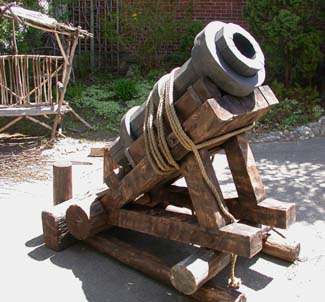- Articles Index
- Monthly Features
- General History Articles
- Ancient Near East
- Classical Europe and Mediterranean
- East Asia
- Steppes & Central Asia
- South and SE Asia
- Medieval Europe
- Medieval Iran & Islamic Middle East
- African History (-1750)
- Pre-Columbian Americas
- Early Modern Era
- 19'th Century (1789-1914)
- 20'th Century
- 21'st Century
- Total Quiz Archive
- Access Account
Cannons
By Rider, 25 July 2006; Revised
Category: Medieval Europe: Military History
The oldest recorded mention of cannons comes from China where Buddhist monks painted a cannon amongst other weapons of war. The painting comes from the year of 1128. The first use of cannons in Europe was in the Siege of Metz (1324) and by the English against the Scots in 1327. The first inscription of firearms in army utilities comes from 1326. A chronicler mentioned that in 1350 the cannon were as widely spread as any other weapon. The first cannons could be divided into two groups: the smaller bronzer weapons and the larger iron cannons. The use of gunpowder helped to make cannons more common. Still it is not known how effective were of how much they were used in battle because battle descriptions tend to exagerate the role of these status symbols. It is sure however that cannons in those days demoralized people who hadn’t seen them before with smoke, noise and fire. The early cannons didn’t always shoot round missiles. The smaller cannons used to fire arrow-like missiles in the 14th century. The arrow-like missiles incorporated a messing stabilizator or a fireproof head. In the beginning the missiles were made of iron but later it was replaced with stone because stone was cheaper than most metals during the 14th and 15th centuries. The round missile was covered with tin. For use against living creatures, pills were invented. In extreme situations nails or iron stuff were used as well. The mounting of cannons on wheels didn’t happen before the 15th century. Before that the guns were pushed onto wooden platforms. The largest siege bombards were tightened with belts onto wood and wood was nailed into the ground. The aiming was done from the platform or wedge like wooden pieces were placed under the cannon. The wooden support frame was put specifically into place for it to suffer the hit.
Early big cannons were built together of iron; they were heated until they glowed as yellow, then hammered together to form a barrel. Iron circles were put over the barrel to put it tighter into place. Smaller cannons were built of messing or bronze using the technique that earlier was used to create statues. In the 16th century the Dutch discovered a way of creating cannon in a pre-built form. The technique was imported into England where the first iron cannon were built in 1543. Making cannons from iron reduced the weight and cost of the cannon so increase the amount of cannons that could be deployed – they greately increased the power of English navy. In the 18th and 19th centuries, the cannon had many roles. They were like today’s automatic guns on the battlefield and were used to diminish the number of enclosing enemies. Larger cannons and mortars were used in sieges and their sole purpose was to make holes into the defensive line of the enemy. The development of the cannon reached its zenith with the innovations of John A. Dahlgren. He was an admiral who devised heavy iron cannon. Such were used on the Confederacy ships during the American Civil War. In 1862 John Gilleland devised multi-barreled cannon that turned up to be an admirable failure. The military use of cannons was decline during the 19th century because of the introduction of smaller and very accurate field guns that could be rear-loaded and fire explosive shells.
|



